Abstract
In the future, the pursuit of high-quality economic development and a focus on ecological environmental protection in China will inevitably result in significant conflicts between land use and ecological land use. Land use conflicts primarily occur in peri-urban areas characterized by prominent economic development and urban agglomeration. As a municipality situated in the Qin-Ba mountainous region, Ankang has been promoting ecological preservation for a span of two decades. The allocation of construction areas primarily focuses on the proximity of watersheds, while the northern and southern regions are predominantly characterized by mountainous and hilly terrain, thus exhibiting distinct regional attributes. Previous studies have mainly focused on analyzing the effects of land use on habitat quality during intense urbanization, with fewer studies focusing on integrating eco-regions with urbanization to assess changes in habitat quality. However, it is important to recognize that land pressure encompasses economic, ecological, and social aspects. Additionally, it aims to provide insights for the harmonious development of land use in eco-region-oriented cities. Using the SSPs-RCPs scenarios provided by the sixth phase of the Coupled Model Intercomparison Project (CMIP6), this paper employs a system analysis method, the emerging Patch-Generating Land Use Simulation model (PLUS) model, Integrated Valuation of Ecosystem Services and Tradeoffs (InVEST) model, and Land Use Conflict Measurement model to dynamically simulate the future habitat quality and spatial conflict patterns of land use in Ankang City. The study explores the spatial coupling effect of both factors under different scenarios. The results indicate the following: (1) The overall development trend reveals an intensification of land use conflicts and a decrease in habitat quality. The expansion rate of construction land is increasing and exhibiting aggregation, while agricultural land area is expanding, and forest land area is continuously decreasing. (2) Land use intensity exhibits a significant positive correlation with land conflict levels, while land conflict levels demonstrate a significant negative correlation with habitat quality. (3) Under different future shared socioeconomic path scenarios, land use intensity, and land conflict levels follow the order of SSP585 (high forcing scenario), SSP370 (medium to high forcing scenario), SSP245 (medium forcing scenario), and SSP126 (low forcing scenario), with intensity and conflict decreasing accordingly. These findings suggest that land use has had some impact on the ecological environment, with indications of habitat degradation. Even in Ankang, where ecological development is highly valued, the city will gradually face conflicts between ecological protection and economic development in future scenarios. The city already has the environment at heart, so it will be worse in cities where the priority is economic development. Therefore, it is crucial to allocate sufficient space for economic development while simultaneously prioritizing ecological protection. The results of the study can provide a reference for analyzing the trade-offs between land development and habitat protection in eco-mountainous cities and for eco-cities to avoid falling into the conflict dilemma of economic cities.
1. Introduction
Land utilization serves as a direct and objective reflection of human activities impacting the natural ecology, representing the intricate interplay between humans and nature [1]. Alterations in land utilization have profound effects on regional ecology, production, climate, and biodiversity [2,3]. The rapid pace of urbanization and industrialization has precipitated swift changes in the spatial arrangement of land utilization, exacerbating the imbalances in its structure. Consequently, conflicts between various land utilization types, such as production, ecology, and habitation, have intensified [4]. Land use conflict primarily pertains to the clashes arising from irrational land utilization patterns, and uncoordinated spatial configurations and quantities, resulting in varying degrees of ecological and environmental degradation [5]. Early research on land use conflict predominantly focused on current situation analysis, employing qualitative analysis methods, comprehensive land use conflict index methods [6,7], map factor superposition methods [8,9], and other modeling approaches [10,11]. However, studies predicting changes in conflict patterns were relatively scarce [12,13]. As the issue of land use conflict continues to escalate, researchers have shifted their attention toward potential future conflicts [14]. This entails collecting spatial data on land use value and demand through Public Participation Geographic Information Systems (PPGIS) to simulate potential conflicts among land types [15]. Additionally, the suitability of different land use types is employed to assess potential conflicts and synergies [16]. Furthermore, studies have emerged that combine land use prediction models to forecast the spatial and temporal evolution of regional conflicts [17,18,19,20].
The future prediction of land use relies on quantitative structure projections and spatial distribution pattern simulations across various scenarios. Multi-scenario simulations effectively unveil the potential correlation between habitat quality and future land use changes. The Shared Socioeconomic Pathways (SSP) scenario framework, developed by Schmitz et al., defines five scenarios that encompass key drivers of land use change, encompassing diverse climates and socioeconomic futures [21,22,23]. The CMIP6 model offers researchers multiple future development scenarios, coupling Shared Socioeconomic Pathways (SSPs) with Representative Concentration Pathways (RCPs) to address global climate change [24]. Regarding quantitative structure prediction of land use, the System Dynamics (SD) model surpasses other models by considering climate change and achieving multiple scenarios of land use demand prediction at different regional scales. This model better captures the nonlinear, dynamic, and systematic characteristics of land use change [25]. However, the SD model alone cannot predict the spatial pattern of land use. By combining the SD model with a land use simulation model, it becomes possible to simulate the spatial distribution of land use more accurately [26]. In terms of spatial distribution pattern simulations, previous studies [27] have not been able to simulate land use patches of natural land use types dynamically and spatially. Commonly used models include the Cellular Automata (CA) model [28,29], Conversion of Land Use and its Effects at Small Regional Extent (CLUE-S) model [30,31], and Future Land Use Simulation Model Software V2.4 (FLUS) [32,33,34,35,36,37,38,39,40,41,42,43,44]. However, PLUS not only retains the advantages of adaptive inertia competition and roulette competition mechanisms found in existing future land use simulation models but also utilizes the random forest algorithm to determine the development potential of each land use type. This allows for a more accurate simulation of changes in land use spatial distribution [35,36,37].
Relevant studies indicate a positive correlation between spatial land use conflict and ecological environment quality [38,39,40]. Both climate change and human activities directly impact habitat quality by altering the land use process. To analyze the influence of habitat quality on land use, it is essential to quantify the degree of land use quantitatively. Additionally, by employing dynamic spatiotemporal simulation of natural land use types, the spatial characteristics of land use conflicts can be revealed through a constructed model based on landscape indices. The Landscape Index-based Land Conflict Measurement model enables accurate identification of conflict locations and the performance of land use conflicts within the spatial structure [41]. Furthermore, in the realm of dynamic modeling of land use change, numerous scholars have utilized land use data to assess habitat quality. This assessment is primarily conducted through hierarchical analysis (AHP) [42], artificial neural network methods (ANN) [43], principal component analysis [44], the InVEST model [45], RS-GIS Unified Ecological and Environmental Quality Evaluation index method [46], and other similar approaches. Notably, the InVEST model offers a concise method to estimate habitat quality based on land use data and habitat threat data. It proves particularly useful when available data are limited, and sampling areas are not feasible [47]. The InVEST model can be utilized to examine the influence of land use change on habitat quality. This approach not only enables the assessment of the extent to which various habitats respond to different sources of threats but also facilitates the evaluation of the interaction among these threat sources.
However, relevant studies did not delve extensively into the ramifications of land conflicts on habitat quality specifically within mountainous eco-cities [48]. Instead, they primarily examined the adverse effects of land use changes on ecosystem services. Existing research has predominantly concentrated on the influence of land use transformations on habitat quality within ecological regions or the interplay between urbanization levels and environmental amenities [49,50]. Few studies have taken a comprehensive conflict-oriented approach by integrating ecological regions with urbanization to assess changes in habitat quality.
Nevertheless, prior research primarily concentrates on land use conflicts and ecological impacts in urban areas, primarily influenced by social and economic factors. There is a dearth of studies examining the effects of land use on habitat quality in mountainous eco-cities or small-scale cities. This paper assesses the evolving patterns of habitat quality in Ankang, a city located in the Qin-Ba Mountain region with ecological preservation, considering future climate scenarios and the ongoing development of land conflicts. The findings hold substantial importance for Ankang’s ecological city in achieving a harmonious balance between environmental conservation and economic progress.
In summary, this study presents a framework that integrates the Sustainable Development (SD) model, PLUS model, InVEST model, and Land Use Conflict Measurement model. This framework aims to examine future land conflicts within the constraints of ecology and urban economic development, using the city of Ankang in the Qin-Ba Mountains as a case study. This study aims to accomplish the following: (1) Determine the direction and scale of land use changes in Ankang City under different scenarios, namely SSP126 (low forcing scenario), SSP245 (medium forcing scenario), SSP370 (medium to high forcing scenario), and SSP585 (high forcing scenario). (2) Analyze the evolutionary process of land use conflicts and habitat quality in Ankang City over the next 30 years, including their spatial patterns. (3) Investigate the potential relationship between habitat quality and land use extent in Ankang, considering future environmental changes and development patterns. This analysis aims to provide guidance for the sustainable utilization of land resources and the establishment of harmonious human–land relationships in similar cities. Additionally, it aims to offer a scientific basis for the formulation of optimal land use policies.
2. Materials and Methods
2.1. Study Area
Ankang is situated in the southeastern region of Shaanxi Province (31°42′~33°49′ N, 108°01′~110°01′ E), within the climatic transition zone of China (Figure 1a), where the Yangtze River and Yellow River systems converge. It serves as a vital water-conservation area for the national South–North Water Diversion Central Project. The region experiences a subtropical continental monsoon climate, characterized by a humid and temperate climate, distinct four seasons, ample precipitation, and a lengthy frost-free period. Ankang is nestled within the mountainous terrain of the Qin-Ba Mountains (Figure 1b), bordered by the Han River, with the Qinling Mountains to the north and the Daba Mountains to the south. This topography (Figure 1c) showcases a prominent pattern of elevated peaks in the north and south, with river basins in the central area. Ankang enjoys a strategic geographical position, serving as the intersection and geometric center of three major economic zones: Guanzhong–Tianshui, Chengdu–Chongqing, and Jianghan. Additionally, it lies in the upstream region of the national Yangtze River Economic Belt and serves as the central hub of the Han River Economic Corridor in Shaanxi Province. Consequently, Ankang faces the challenge of balancing land utilization for economic development, agricultural production, and ecological preservation due to the increasing demand for land resources.
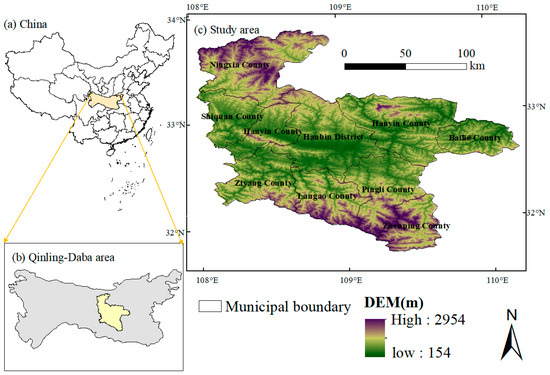
Figure 1.
Study area of Ankang. (a) Overview of the Qinba Mountains in China; (b) Location of the study area; (c) Elevation map of study area.
2.2. Data Sources
The data required for this study contain land use, socioeconomic, natural factors data, etc., as shown in Table 1.

Table 1.
Research data and sources.
(1) Data sources for the System Dynamics (SD) model: The data required for the SD model in this study comprise three components: land use; socioeconomic; and meteorological. Among these, the 30-m land use data for the years 2000, 2010, and 2020 were obtained from the National Geographic Information Resources Catalogue Service System (https://www.webmap.cn/), accessed on 12 April 2023. The socioeconomic data were sourced from the Shaanxi Statistical Yearbook, Ankang Statistical Yearbook, and Ankang Annual Statistical Bulletin, spanning the years 2000 to 2020. Meteorological data primarily include the average temperature and average precipitation for each year from 2000 to 2020 at each meteorological station in Ankang City. These data were acquired from the National Climatic Data Centre (https://www.ncdc.noaa.gov/), accessed on 12 April 2023.
(2) Data sources of the PLUS model: The data utilized in the PLUS model for this study encompass land use and driver data. The land use data originate from the same source as the SD model. As for the driver data, these encompass various types, including GDP data (with a spatial resolution of 1 km) obtained from the CAS Resource and Environment Data Cloud (REDCloud), and Population Density data (with a spatial resolution of 1 km) obtained from the NASA Socio-Economic Data and Applications Centre (SEDAC) for socioeconomic data (https://sedac.ciesin.columbia.edu), accessed on 18 April 2023. The natural environment data (such as temperature, precipitation, dryness, soil type, soil erosion type, NDVI, NPP, soil erosion intensity, and farmland production potential) with a spatial resolution of 1 km were acquired from the CAS Resource and Environmental Science Data Centre (RESDC). The Digital Elevation Model (DEM) data with a spatial resolution of 30 m were obtained from the Geospatial Data Cloud (https://www.gscloud.cn), accessed on 18 April 2023. The night light data with a spatial resolution of 500 m were obtained from the VIIRS_DNB_VNLV2 dataset provided by the Earth Observation Group (EOG) (https://eogdata.mines.edu), accessed on 18 April 2023. Vector data (including roads, railways, rivers, water resources, and residential points) were obtained from the National Geographic Information Resources Catalogue Service (https://www.webmap.cn/), accessed on 18 April 2023.
(3) Data for the Land Use Conflict Measurement model: The land use data used in the Land Use Conflict Measurement model were sourced from the same provider as the SD model, with the data for 2030, 2040, and 2050 obtained from the results of the PLUS model. The shapefile (shp file) delineating the administrative area scope of Ankang City, Shaanxi Province, was obtained from the AliCloud data visualization platform (http://datav.aliyun.com/portal/school/atlas/area_selector), accessed on 25 April 2023.
(4) Data for the InVEST model: The land use data originated from the identical source as the SD model, while the data for 2030, 2040, and 2050 were obtained from the PLUS model outcomes. The threat source data were derived from the land use projection data simulated by the PLUS model.
2.3. Research Methods
The proposed framework (Figure 2) in this study comprises four primary components. (1) Initially, scenario simulation parameters are established based on the anticipated socioeconomic and climate change datasets across various SSP-RCP scenarios. The SD model is then employed to simulate land use demand in Ankang under these diverse scenarios. (2) Subsequently, the PLUS model is utilized to forecast the spatial distribution of land use under different future scenarios. (3) Furthermore, the Integrated Spatial Conflict Measurement model is employed to examine the temporal evolution and spatial differentiation of land use conflicts in Ankang. Additionally, the InVEST model is utilized to predict habitat quality in Ankang under four scenarios. (4) Lastly, a bivariate spatial autocorrelation analysis is conducted to unveil the spatial correlation between land use conflict and habitat quality in Ankang.
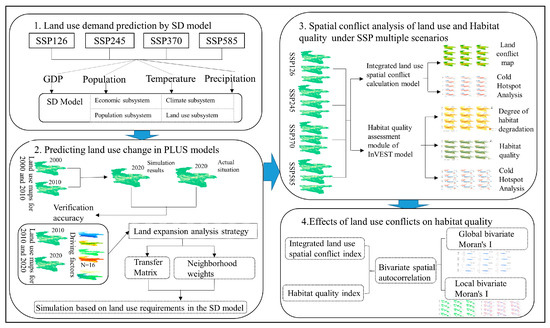
Figure 2.
Research framework diagram.
2.3.1. SSPs-RCPs Scenarios
CMIP6 represents a synthesis of various scenarios derived from the Shared Socioeconomic Pathways (SSP) and Representative Concentration Pathways (RCP). It highlights the significance of diverse socioeconomic development patterns in influencing climate change [51]. The simulated scenarios for future climate change encompass the timeframe of 2020–2050. Scenario parameters were tailored to the study area (Table 2), and average annual changes were computed at ten-year intervals. Detailed specifications for each scenario can be found in Table 3.

Table 2.
Study area setting scenario parameters and sources.

Table 3.
Parameter settings for different climate scenarios from 2020 to 2050.
2.3.2. System Dynamics Model
The System Dynamics (SD) model developed in this research comprises four primary subsystems: economic; population; climate; and land use [59]. By utilizing land use, socioeconomic, and meteorological data from Ankang City spanning the years 2000 to 2020, the study examines the feedback and interaction relationships among each subsystem and variable. Subsequently, it determines the variations in each variable and establishes quantitative relationships between them. The Vensim PLE 7.3.5 software was employed to construct the System Dynamics model of land use change in the study area (Figure 3).
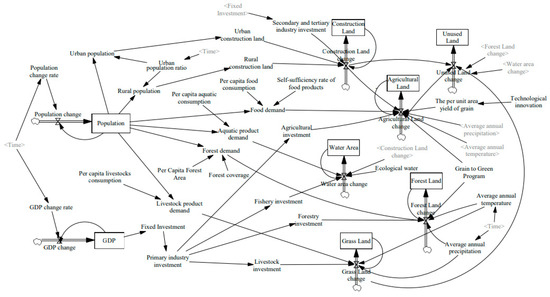
Figure 3.
SD model of land use demand in Ankang (The arrows indicate cause and effect).
2.3.3. PLUS Model
The PLUS model incorporates the rule mining framework utilizing the Land Expansion Analysis Strategy (LEAS) model and the Cellular Automata (CA) model based on multi-type Random Seeds (CARS) [44]. In this investigation, land use data for two time periods spanning from 2010 to 2020 (Figure 4), along with factors such as elevation, slope, temperature, precipitation, farmland production potential, soil type, soil erosion type, population density, GDP, Night Lighting index, NPP, distance from highways, distance from other urban roads, distance from railways, distance from river systems, and distance from settlements, were utilized as predictor variables (Figure 5) within the PLUS model to determine the probability of suitability for each land use type in Ankang.

Figure 4.
Ankang land use map for 2000, 2010, and 2020.
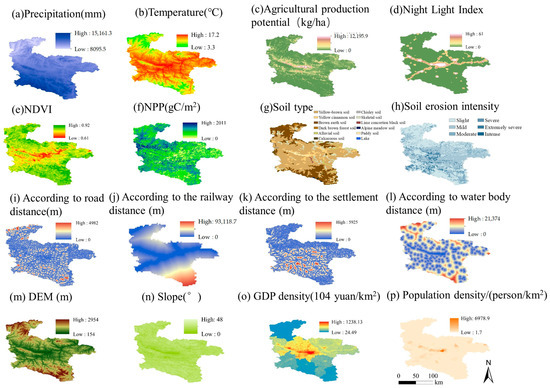
Figure 5.
Driving factor indicators.
2.3.4. Land Use Conflict Measurement Model
The Land Use Conflict Measurement model, utilizing the Landscape Pattern index, serves the purpose of not only expressing spatial land use conflicts but also revealing regional ecological risks [60]. In this research, the designated study area is divided into multiple 6 km × 6 km grid cells, which are employed as evaluation units for assessing land use spatial conflicts. In order to account for the spatial patches that extend beyond the study area’s boundary and are not fully covered by the grid, these patches are considered as one complete grid. The calculation of the landscape index is performed using the Fragstats4.2 software (Table 4). Land use spatial conflict analysis must take into account three key aspects: system complexity; vulnerability; and dynamics. Additionally, a comprehensive calculation model for land use spatial conflict (Equation (1)) can be abstracted as the “complexity (Equation (2)) + vulnerability (Equation (3)) − stability (Equation (4))” of the land use system.

Table 4.
Land Use Conflict Measurement model construction.
2.3.5. InVEST Model
Habitat quality refers to the ecological capacity to offer optimal conditions for natural ecological processes, taking into account regional habitat fragmentation and the ability to withstand habitat degradation [63]. The primary parameters utilized in the modeling process encompass the extent of influence exerted by threat sources along with their corresponding weights. Additionally, the habitat suitability and sensitivity to each threat source are also considered. The specific values for these parameters can be found in Table 5 and Table 6, respectively. The determination of these values was based on recommended reference values from the modeling framework and relevant literature [64,65,66]. The Habitat Quality Module of the InVEST model assesses habitat quality by Formula (5): where Qxj denotes the habitat quality of raster x in land use type j; Hj denotes the habitat suitability of land use type j; Dxj denotes the level of stress on raster x in land use type j; z denotes the normalization constant; and k is the scaling constant, where Dxj in Equation (5) was calculated as follows:
where R is the number of stressors; r is the stressor; y is the grids number of stressors r; Yr is the grid number occupied by the stressor; Wr is the stressor weight, taking values ranging from 0 to 1; irxy is the effect (exponential or linear) of stressor r on each grid of the habitat; βx is the habitat disturbance resistance level; Sjr is the relative sensitivity of different habitats to each stressor.

Table 5.
Threat source attributes.

Table 6.
Sensitivity of different land types to threat sources.
2.3.6. Spatial Heterogeneity Analysis of Land Use
Hotspot analysis, as a local spatial autocorrelation index, can be employed to examine the spatial concentration of ecological or environmental variables and their clustering patterns [67]. The Getis-Ord Gi* index [Gi*(d)] is utilized to identify regional hotspot analysis.
where Wij is the spatial weight matrix; Xi is the sample value of i.
To analyze and study the heterogeneity of the spatial distribution of different land conflict units, the global Moran’s I index was utilized to examine the spatial autocorrelation characteristics of the land use spatial conflict index [68].
where n is the total number of conflicting units; is the collision average; are conflicting values at positions i and j; Wij is the spatial weight matrix. The Bivariate Local Spatial Autocorrelation index assesses the level of correlation and spatial aggregation between the attribute value of a spatial unit and the corresponding attribute value on its neighboring spatial units [69].
where Wij is the spatial weight matrix between cell i and cell j; xi is the attribute value of cell i; is the average of all attribute values; n is the total number of regional cells.
3. Results
3.1. Land Use Analysis
3.1.1. Land Use Demand Prediction in Ankang Based on the SD Model
The SD model encompassed a simulation period from 2000 to 2050, with a yearly time step. The historical simulation phase covered the years 2000 to 2020, during which historical data from the Statistical Yearbook were utilized to evaluate the simulation results. The accuracy of the simulation model was assessed using historical data, specifically from 2020. Once the accuracy of the System Dynamics model was verified, the base year for each scenario simulation was set as 2020, and different scenario parameters were inputted to simulate changes in future land use demand.
The values of the variables in the SD model were established to determine the desired extent of each land use type from 2000 to 2020, using statistical data from 2000 as a basis. The simulation outcomes for 2020 were then compared with the actual data to assess the accuracy of the SD model (Table 7). The results indicate that the disparities between the simulated and actual data were minimal, with errors of less than 2.5%. This suggests that the model exhibits a high level of simulation accuracy and is capable of predicting future land use patterns.

Table 7.
Comparison between projected results and actual data in 2020 (ha).
Based on the 2020 land use data, the parameters corresponding to different climate change scenarios were input into the aforementioned SD model for simulation, resulting in prediction outcomes (Figure 6). The results indicated variations in land use demand across the four climate scenarios. In all scenarios, there is an increase in the area of construction land, agricultural land, and grassland. The SSP585 scenario exhibits the highest growth rate in construction land, grassland, and agricultural land area, followed by the SSP370 and SSP245 scenarios, while the SSP126 scenario has the lowest growth rate. Conversely, there is a decrease in the demand for forest land area in all scenarios, with the SSP585 scenario experiencing the most significant decline, while the other scenarios remain relatively stable. Additionally, the area of unused land and water witness varying degrees of reduction across the four scenarios, with the SSP245 scenario showing a smaller change in unused land area. Notably, the SSP585 scenario demonstrates the most pronounced changes in land use types, resulting in a larger area of unused land.

Figure 6.
Land use demand obtained from SD model simulation.
3.1.2. The PLUS Model Simulates the Future Land Use Distribution in Ankang
The 2010 land use data served as the base map for the simulation in the SD model, and the resulting land use simulation data for 2020 were compared and validated with the actual land use data from that year using the PLUS model to evaluate the accuracy of the simulation. After confirming that the simulation accuracy met the requirements of the study, the land use demand for 2030, 2040, and 2050 in Ankang City, under each scenario simulated by the SD model, was sequentially inputted into the PLUS model to predict the future spatial and temporal dynamics of land use patterns. The results indicated an overall classification accuracy of 0.96 and a Kappa coefficient of 0.94 in the PLUS model, demonstrating a high level of simulation accuracy and effectiveness in simulating land use changes.
The simulation accuracy was deemed sufficient to meet the research requirements. Utilizing the land use data from 2020, the land use demand for 2030, 2040, and 2050 in Ankang, under each simulated scenario using the SD model, was input into the PLUS model to forecast the future spatial and temporal dynamics of land use patterns in Ankang (Figure 7, Table 8). The findings indicated that under the SSP126 scenario, the overall trend of agricultural land expansion follows the course of the Han River, with minimal aggregation except for the river and an expansion of existing grassland areas. In regions with established ecological foundations, such as the Qinling Mountains in the north and the Daba Mountains in the south, the forested areas experience minimal changes, and the expansion of construction land slows. The agricultural land expansion pattern under the SSP245 scenario was similar to SSP126, with a slight increase in grassland area. Forested areas are better preserved in the northern and southern parts of the study area. The expansion of construction land is gradual and fragmented. Under the SSP370 scenario, the agricultural land expansion pattern resembles the previous scenarios, with an increase in both grassland and construction land areas. Agricultural land encroaches upon the grassland in the basin and valley, squeezing the scattered forested spaces along the river, while construction land becomes more concentrated. In the SSP585 scenario, rapid agricultural land expansion leads to the conversion of grassland into forest land in the central valley. Simultaneously, construction land expands swiftly along both sides of the river, encroaching upon other land types. Compared to the SSP126, SSP245, and SSP370 scenarios, the SSP585 scenario exhibits a larger area of construction land.
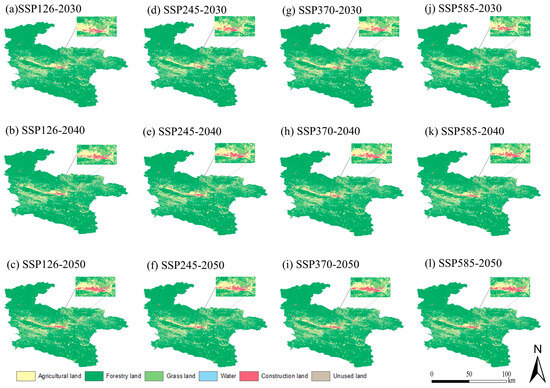
Figure 7.
Land use in 2030, 2040, and 2050 from PLUS model simulations.

Table 8.
PLUS model simulation land use results (ha).
3.1.3. Spatial and Temporal Analysis of Land Use Conflicts in Ankang
Based on the distribution characteristics of the cumulative frequency curve, the evolution of land use conflicts follows an inverted “U” shape. The stable region constitutes a significant portion of the entire region, whereas the runaway region represents a minor fraction. The controllability levels of land use conflicts can be classified as follows: stable and controllable; basically controllable; basically out of control; and seriously out of control [70]. Wang et al. [71] confirmed the applicability of using a Land Conflict Measurement model based on landscape index in mountainous cities. To classify the comprehensive land use conflict index into four levels, the Natural Breakpoint method was employed. These levels were defined as follows: stable and controllable (0, 0.35); basically controllable (0.35, 0.7); basically out of control (0.7, 0.9); and seriously out of control (0.9, 1.0).
In general, the land use conflicts in the middle reaches of the Han River have been highly intense, and their spatial distribution characteristics are evident (Figure 8). First, the areas exhibiting high overall land use conflict indices are primarily concentrated in the town center, where human activities are more active (such as the Hanbin District). This is because the Hanbin District serves as the political, economic, and transportation hub of Ankang, and economic development has exacerbated land use conflicts. Other districts and regions experienced low land use conflict, with higher conflict values mainly observed around the town center. However, over time, land conflicts have intensified and spread towards the outskirts of the town. Second, the areas with low land use conflicts are predominantly found in the northern Qinling region and the southern Daba Mountains. These areas are characterized by mountainous and hilly terrain, with abundant vegetation coverage and minimal human disturbance, resulting in reduced land use conflicts. Furthermore, the results indicate that the high land use conflict areas are distributed along both sides of the Han River system. This distribution reflects the demand for water resources and transportation by land exploiters and users.

Figure 8.
Land use conflict for 2000, 2010, and 2020.
The spatial distribution patterns of land use conflicts under the four future scenarios remain generally consistent for the next 30 years, exhibiting a distribution pattern characterized by a “high center, low north and south, distribution along the river plain, and westward development” (Figure 9).

Figure 9.
Future land use conflict maps for 2030, 2040, and 2050.
Due to a combination of human activities, social and economic development, nature conservation policies, and natural factors such as topographic relief, biodiversity, and river water sources, the expansion of land use in Ankang is constrained by the hills and mountains. High-conflict areas cannot expand into low-conflict areas in the north and south. Instead, land use conflicts tend to spread along the Han River and its surrounding areas, forming a basin that can be managed to some extent. Among the different land use simulation scenarios, SSP585 exhibits the most intense land use changes, with extensive and concentrated out-of-control areas. The tendency to encroach into the surrounding regions is evident from the beginning. The out-of-control pattern gradually spreads to the basically controllable areas, particularly in the north and south. In the SSP370 scenario, land use development increases, accompanied by high land use conflicts. Compared to the SSP245 and SSP126 scenarios, large out-of-control areas appear early on. These areas mainly expand from basic out-of-control regions to basic controllable areas, as well as toward the western plains, resulting in a larger outbreak of out-of-control areas. The SSP245 scenario demonstrates relatively stable land use changes, maintaining an existing growth trend with moderate complexity. Although the intensity of land use conflicts gradually increases, the out-of-control regions are somewhat restricted within manageable limits, indicating some level of human intervention in controlling these areas. Among the four scenarios, the SSP126 scenario exhibits the least out-of-control simulation. Land use changes remain stable, and the out-of-control conflict areas are effectively curbed. There is a slight expansion of stable and controllable areas, such as the northern Qinling Mountains and the southern Daba Mountains.
Moran’s I index is utilized to measure spatial autocorrelation, and the correlation of the Land Use Conflict index can be verified through autocorrelation analysis. In the study area, the Moran’s I index for the 2010 and 2020 data was 0.611 and 0.778, respectively, with p-values less than 0.01 and Z-scores greater than 2.58. This indicates a positive spatial correlation and significant spatial autocorrelation across the scenarios in the study area. To better illustrate the spatial clustering of land use conflicts, the Getis-Ord Gi* statistics were employed to examine the relationship between each element and its adjacent environment. Subsequently, a cluster distribution map with high and low values (Figure 10) was generated to further illustrate the local variability in land use spatial conflicts. The evolution of land use spatial conflicts at the grid level serves as a microcosm of land use change in the grid area. The hot spot areas are primarily located along both sides of the Han River and tend to spread towards the periphery, while the cold spot areas are situated in the mountainous hills in the north and south, exhibiting a steady increase. In the SSP126 scenario, the hot spots continue the historical chronological trend, while the cold spots remain relatively stable. In comparison, the hotspot areas in the SSP245 scenario expand eastward, displaying higher values and greater aggregation along the river. The SSP370 scenario represents a substantial land use change with more concentrated and pronounced aggregation. The hotspot areas in the SSP585 scenario exhibit the largest extent and strongest aggregation, while the cold spot areas shrink and become less aggregated, yet still demonstrating a north–south distribution pattern.
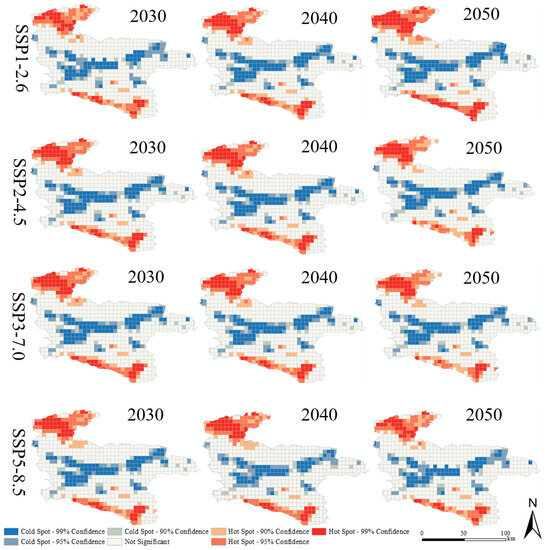
Figure 10.
Spatial clustering hotspot analysis under scenarios simulation.
3.2. Habitat Quality Analysis
3.2.1. Habitat Quality Classes in Ankang
The habitat quality module in the InVEST model was utilized to predict the habitat quality in Ankang City under different scenarios from 2030 to 2050. The results are presented in Table 9, which displays the habitat quality classes in Ankang, and Figure 11, which illustrates the spatial distribution of habitat quality.

Table 9.
Habitat quality classes (%) and mean and standard deviation in Ankang.
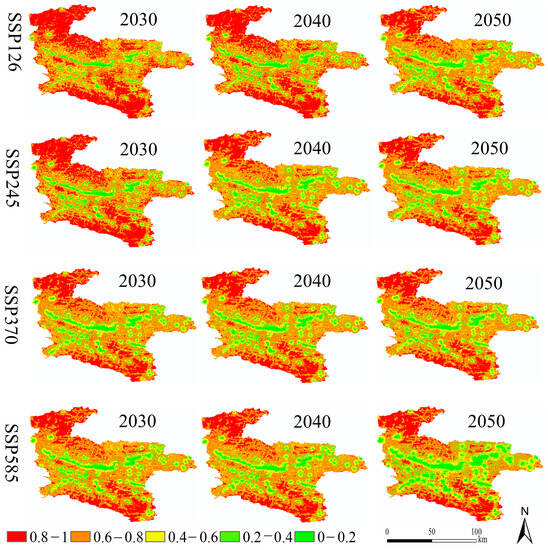
Figure 11.
Habitat quality classes in Ankang under various scenarios.
Figure 11 reveals that areas with high habitat quality levels (Level > 0.6) are concentrated in the Qinling region in the north and the Daba Mountain region in the south. Conversely, areas with lower habitat quality levels (Level < 0.4) are clustered in the Han River valley. The buffer zone where the Han River basin meets the Qin-Ba Mountain region exhibits a concentration of areas with medium habitat quality levels.
Table 9 demonstrates that under the SSP126 scenario, areas with high habitat quality levels are well protected, while areas with low ecological quality levels are controlled, resulting in a gradual improvement in habitat quality. By 2050, the mean habitat quality in Ankang has been maintained at 0.6429, indicating the effectiveness of the SSP126 scenario in enhancing habitat quality. In contrast, the SSP245 scenario shows a slight decline in overall mean habitat quality, with a shift from high habitat quality areas to lower classes. The SSP370 scenario exhibits a further decline in mean habitat quality, characterized by an increase in low-level habitat quality and a transition from high to low levels. Under the SSP585 scenario, habitat quality classes are regionally distributed, and there is a notable shift from intermediate habitat quality levels to lower levels. By 2050, the average habitat quality in Ankang will gradually decrease to 0.5360. Furthermore, the standard deviations for the four scenarios indicate variations in habitat quality from 2030 to 2050. However, these changes tend to become progressively more stable without significant spikes or decreases.
3.2.2. Habitat Quality Spatial Distribution Characteristics
The predicted spatial distribution pattern for different future scenarios exhibits a more pronounced regional clustering, as shown in Figure 12. The average Moran’s I value for habitat quality under these scenarios was approximately 0.65, with a statistically significant positive correlation (p-value < 0.001), indicating spatially significant clustering of habitat quality in Ankang. Figure 12 illustrates that Ankang displays distinct spatial clustering characteristics, with high-value clusters primarily concentrated along the Qinling Mountains and in the Daba Mountains, while low-value clusters are concentrated near the Han River basin. In the SSP126 scenario, the high-value cluster areas gradually expand outward towards the periphery over time, suggesting that habitat quality in this scenario can extend well beyond the central high-value areas. In the SSP245, SSP370, and SSP585 scenarios, the high-value areas (with >95% confidence) expand towards the high-value areas (with 90% confidence), and there is a tendency for the high-value areas (with 90% confidence) to shift towards the nonsignificant areas. As economic development and urbanization intensify and anthropogenic disturbance increases, the habitat quality trend in the middle and lower clusters shows a progressive increase and peripheral diffusion.
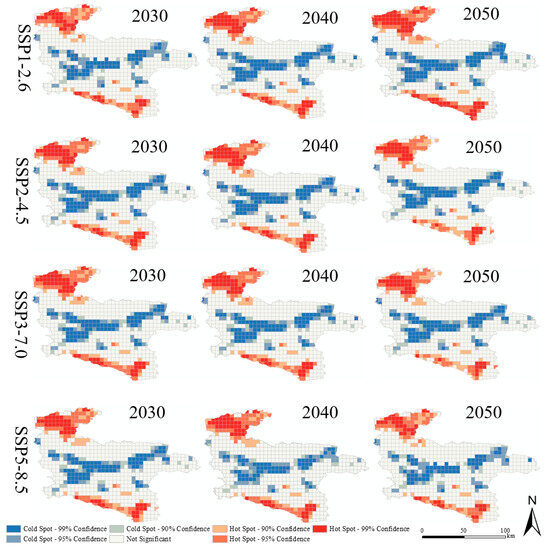
Figure 12.
Spatial clustering diagram under scenarios simulation.
3.3. Influence Analysis between Habitat Quality and Land Use Conflicts
The global bivariate Moran’s I analysis conducted for land use conflict and habitat quality in Ankang (Figure 13) revealed that Moran’s I index exhibits a negative value in all predicted scenarios, with a p-value of 0.005. These findings suggest a significant negative spatial correlation between land use and habitat quality, indicating that land use conflict will result in the degradation of habitat quality.
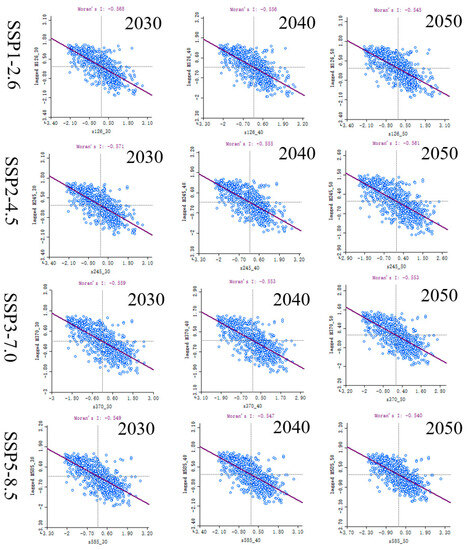
Figure 13.
Bivariate Moran’s I scatter plot for land use conflict and habitat quality.
In Figure 14, the spatial clustering patterns for the bivariate analysis of land use conflict and habitat quality exhibit a significant correlation across most regions. Furthermore, the spatial clustering patterns for land use conflict (Figure 10) and habitat quality (Figure 12) demonstrate a contrasting distribution.
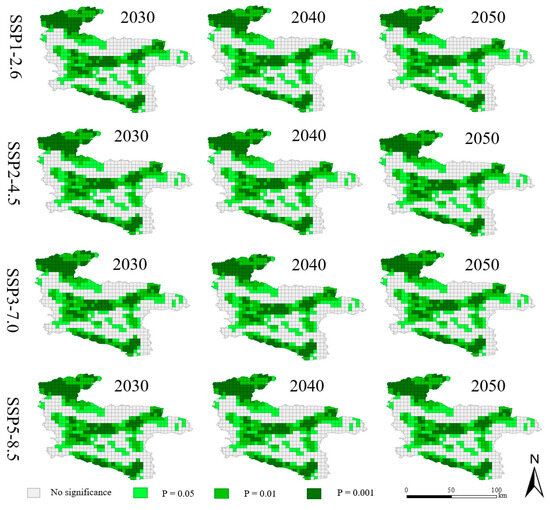
Figure 14.
Bivariate LISA Significance Map for land use conflict and habitat quality.
Figure 15 illustrates that the primary spatial clustering patterns consist of the high–low type (characterized by high land use and low habitat quality) and the low–high type (characterized by low land use and high habitat quality). The high–low type is predominantly found along the Han River basin and in proximity to railway and road transport routes, primarily concentrated in areas with intense human activity. On the other hand, the low–high type is mainly located in areas distant from human activity, specifically the Qin-Ba Mountains, owing to its unique geographical location and ecological protection measures.
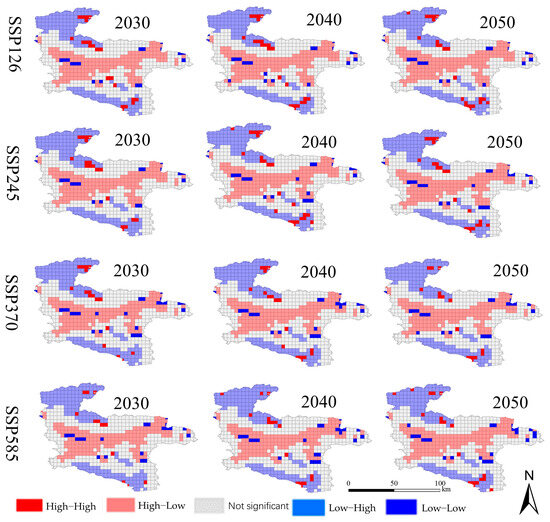
Figure 15.
Bivariate LISA clustering map for land use conflict and habitat quality.
Additionally, the low–low type (characterized by low land use and low habitat quality) is primarily distributed in towns and transitional zones between the plains and the Qin-Ba Mountains within the Han River basin. Conversely, the high–high type (characterized by high land use and high habitat quality) is scattered throughout the region.
To summarize, the high–low type signifies the overexploitation of local resources, the high–high type indicates a balance between ecological protection and economic considerations, the low–high type represents a high level of ecological protection, and the low–low type represents the worst outcome with neither ecological nor economic benefits.
4. Discussion
4.1. Significant Differences in Land Use Conflicts and Habitat Quality under SSP-RCP Scenarios
This study predicted the spatial and temporal patterns of land conflict levels and habitat quality in Ankang from 2030 to 2050. Analyzing the predicted results of different land use scenarios in Ankang City from 2030 to 2050, it has been determined that the SSP126 scenario would lead to improvements in habitat quality and better control of land use conflicts. It is worth noting that a development model focused solely on economic benefits, as observed in a related study [72], inevitably increases ecological risks compared to the results obtained under the SSP585 scenario in this study. Simulations were conducted to analyze land use patterns and habitat quality under multiple scenarios, which yielded notable spatial effects. The results obtained from these simulations align with the evaluation findings of Wu et al. [73]. Specifically, the SSP126 scenario indicates an increasing trend in habitat quality, while the SSP585 scenario shows a degradation trend. The SSP245 and SSP370 scenarios demonstrate moderate habitat quality.
4.2. Changes in Land Types Lead to Intensified Land-Use Conflicts
In the context of rapid urbanization, the pursuit of high-quality economic growth, and the increasing significance of ecological preservation, urban land expansion in Ankang, situated in the Qin-Ba Mountains, has primarily concentrated on the areas surrounding the valley basin along the Han River. This has resulted in encroachment upon agricultural and forested land within the river basin valley, leading to detrimental effects on both the living environment and ecological space. The underlying cause of this issue lies in the conflict between land utilization for construction purposes and agricultural activities, which stems from the limited availability of land resources in the face of growing demands. Conflicts frequently arise between agricultural and construction land, with agricultural land often being at a disadvantage in proximity to construction sites. This is due to the prioritization of urban construction activities over food production and the creation of favorable conditions for economic development, which, in turn, yield greater economic benefits. Consequently, agricultural production is negatively impacted, hindering the achievement of sustainable development goals. Overall, the spatial arrangement characterized by a mixture of land uses and high heterogeneity surrounding the Ankang municipality has resulted in the aggregation of land use conflicts. In contrast, the corresponding Qin-Ba Mountains, located far from human activities and subject to stringent ecological protection measures, contribute to the preservation of high-quality habitats. Within the Han River basin valley, the unique geographical position of Ankang, coupled with its predominantly hilly terrain, severely limits the availability of development space. As a result, construction land in Ankang primarily encroaches upon agricultural and forested land, expanding outward from the core urban area. This, in turn, leads to a more significant reduction in agricultural land around the downtown region. Consequently, rural development land is squeezed and pushed farther away from the urban periphery, resulting in fragmentation and, ultimately, exacerbating conflicts. From an ecological perspective, the pattern of the river valley significantly influences the land use pattern in Ankang, further intensifying land use conflicts within the city and exerting a profound impact on its urban development.
4.3. Habitat Quality Response to Land Type Change
There are disparities in the alteration of habitat quality in Ankang across the four distinct future development scenarios, and the overall trajectory of habitat quality aligns with the patterns of land utilization. The Qinling region and the Bashan Mountains exhibit superior habitat quality compared to the central region, owing to their extensive forest and grassland coverage and minimal human-induced activities. Conversely, the Han River Valley basin experiences relatively diminished habitat quality due to socioeconomic progress, expansion of construction land, and the degradation of habitats threatened by agricultural practices. In the SSP126 scenario, regulated construction land results in a deceleration of economic growth, leading to an expansion of woodland and grassland areas, which in turn enhances habitat quality. In contrast, the SSP585 scenario exhibited the lowest habitat quality among all scenarios, attributed to unregulated economic development and reduced ecological protection. Consequently, alterations in land utilization patterns have a discernible impact on habitat quality, contingent upon changes in response to climatic, economic, and governmental factors. The findings suggest that habitat quality exhibits a notable response in areas characterized by concentrated land use changes (conflict zones) while displaying less significant changes in regions with limited land use alterations (non-conflict zones).
4.4. Effects between Land Use and Habitat Quality
Research conducted on land use and habitat quality in significant ecosystems such as the Qinling Mountains and Han River indicates that urban construction land expansion and economic development should be restricted in ecological protection areas. Fragmentation of production and livelihood land poses a threat to ecological land, leading to habitat degradation, which is consistent with previous studies [74]. These findings suggest that land use change directly influences changes in ecological quality. Human activities associated with land use contribute to environmental changes, which subsequently impact ecosystems, aligning with the conclusions drawn by Zhao et al. regarding the trade-offs between human activities and ecosystem services. Across all scenarios, there was a tendency for construction land and agricultural land areas to increase and concentrate around the town center in Ankang and the Han River valley, resulting in a decline in habitat quality. These results confirm the effects of changes in construction land and agricultural land areas on habitat quality. Notably, the construction of land has the most pronounced impact on habitat quality, while alterations in unused land and agricultural land areas directly influence changes in habitat quality.
5. Conclusions
As the representative of an inland, ecological city in China, Ankang City has a good ecological environment and advantageous development environment. The increase or decrease in various types of land use will affect the change in habitat quality in Ankang. With the increasing influence of human activities, the habitat quality in Ankang City has changed significantly. Based on the System Dynamics and PLUS model for forecasting future land use, four scenarios (SSP126, SSP245, SSP370, and SSP585) with distinct socioeconomic development patterns were selected to project future land use intensity, evaluate future land conflict levels, and assess habitat quality in the region. The objective was to examine the spatial and temporal effects on the future state of land conflicts and habitat quality under different climate and socioeconomic change scenarios. The findings revealed that the primary spatial clustering patterns for land use and habitat quality exhibited a high–low type (high land use and low habitat quality) and a low–high type (low land use and high habitat quality), demonstrating a significant negative correlation.
In conclusion, the impact on habitat quality under different future land use scenarios will rely on effective land use governance and planning, as well as external factors such as climate change. The achievement of ecological conservation and sustainable economic development necessitates prudent planning and management. Even in Ankang, where ecological development is prioritized, the city will gradually encounter conflicts between ecological conservation and economic development in future scenarios.
The research results can provide suggestions for the analysis of urban land development in ecological mountain areas and provide references for ecological cities to avoid falling into the dilemma of economic city conflicts. Ankang boasts a favorable geographical location, excellent transportation infrastructure, abundant tourism resources, and a green industrial base. However, its overall development lags behind neighboring cities in terms of scale and progress. The land use pattern along the many river valleys not only supports urban development but also favors the development of ecological resources. Given the persistence of land conflicts and the endangerment of habitat quality in Ankang, a city that places a high priority on environmental protection, the severity of habitat quality and land use conflicts is exacerbated in cities that prioritize economic development. It is imperative to direct our attention toward safeguarding environmental amenities not only in economically driven cities but also in eco-cities in order to mitigate the potential for conflicts and harness their ecological benefits. By capitalizing on their advantageous ecological resources, eco-cities can establish sustainable industries and stimulate economic growth, rather than adopting the development approach employed by economically focused cities. The results suggest that the future development space in Ankang will be constrained within the context of ecological conservation, leading to heightened land use conflicts in urban areas, which will result in ecosystem degradation and ultimately diminished habitat quality. The findings indicate that Ankang must reconcile economic development and ecological protection based on ecological conservation principles. Sufficient room for economic development should be allocated without encroaching on areas designated for environmental protection, thereby fostering harmonious human–land relationships while ensuring robust economic progress. The Ankang municipality and rational planning of land use change in complex mountainous environment protection and resource development in coordination are of great significance.
6. Limitations
First, the comprehensive exploration of future land use changes on habitat quality remains incomplete. Our current study focused solely on the dynamic changes in land use conflict and habitat quality in Ankang, an ecologically oriented city, from 2030 to 2050. We established their spatial correlation but did not consider other perspectives, such as mathematical or physical models, which should be incorporated into future studies for a more comprehensive analysis.
Second, our study only examined the spatial association between land use and habitat quality, neglecting the impacts of land use on other elements of ecosystem services. In future studies, we will delve deeper into exploring these impacts to gain a more thorough understanding.
Third, there is a need to further enrich and improve the indicator construction system. Additionally, it is crucial to incorporate other factors that influence human activities and socioeconomic development to enhance the simulation of land use demand, land use change, and habitat quality change.
Lastly, our study selected only four typical climate scenarios and social development models, which introduces uncertainty in the predictions made by the SD-PLUS model. To mitigate this uncertainty, future studies should refine scenario parameters to better measure the future effects of land use change on habitat quality. It is also important to target areas with different social service orientations to accommodate sustainable future development.
Author Contributions
Conceptualization, X.L.; methodology, S.C.; formal analysis, S.C.; data curation, S.C.; writing—original draft preparation, S.C.; writing—review and editing, S.C.; visualization, S.C.; supervision, Y.W., G.Z., L.Z. and C.W. All authors have read and agreed to the published version of the manuscript.
Funding
This research received no external funding.
Data Availability Statement
All data and materials are available upon request.
Acknowledgments
We would like to thank the reviewers for their thoughtful comments that helped improve the quality of this work.
Conflicts of Interest
The authors declare no conflict of interest.
References
- Tang, H.J.; Wu, W.B.; Yang, P.; Chen, Y.Q.; Verburg, P.H. Recent Progresses of Land Use and Land Cover Change (LUCC) Models. Acta Geogr. Sin. 2009, 64, 456–468. [Google Scholar]
- Rodrigo-Ilarri, J.; Romero, C.P.; Rodrigo-Clavero, M.-E. Land Use/Land Cover Assessment over Time Using a New Weighted Environmental Index (WEI) Based on an Object-Oriented Model and GIS Data. Sustainability 2020, 12, 10234. [Google Scholar] [CrossRef]
- Dai, E.; Ma, L.; Yang, W.; Wang, Y.; Yin, L.; Tong, M. Agent-based model of land system: Theory, application and modelling framework. J. Geogr. Sci. 2020, 30, 1555–1570. [Google Scholar] [CrossRef]
- Bohua, Y.U.; Changhe, L.V. The Progress and Prospect of Land Use Conflicts. Prog. Geogr. 2006, 25, 106–115. [Google Scholar]
- Lu, S.; Zhang, J.; Wu, Z. Study on the Spatial Conflict of Land Use in Jinghe County Oasis. J. Ecol. Rural. Environ. 2022, 38, 428–436. [Google Scholar]
- Yang, Y.; An, Q.; Zhu, L. Diagnosis Based on the PSR Model of Rural Land-use Conflicts Intensity. Prog. Geogr. 2012, 31, 1552–1560. [Google Scholar]
- Bao, W.; Yang, Y.; Zou, L. How to reconcile land use conflicts in mega urban agglomeration? A scenario-based study in the Beijing-Tianjin-Hebei region, China. J. Environ.Manag. 2021, 296, 113168. [Google Scholar] [CrossRef]
- Li, Q.; Wu, X.; Wang, M. Identification of Potential Land Use Conflict in Desertification Area at the County Level. Acta Sci. Nat. Univ. Pekin. 2018, 54, 616–624. [Google Scholar]
- Liu, Q.Q.; Zhao, H.F.; Wu, K.N.; Yu, X.; Zhang, Q. Identifying Potential Land Use Conflict Based on Competitiveness of Different Land Use Types in Beijing, China. Resour. Sci. 2014, 36, 1579–1589. [Google Scholar]
- Zhang, J.; Sheng, H.; Liu, Y.; Meng, Z. Sustainability Assessment of Land Consolidation Based on the Improved Grey Target Modela Case of Jiangsu Province. Resour. Environ. Yangtze Basin 2014, 23, 153–160. [Google Scholar]
- Liu, X.; Shu, J.; Zhang, L. Research on applying minimal cumulative resistance model in urban land ecological suitability assessment: As an example of Xiamen City. Acta Ecol. Sin. 2010, 30, 421–428. [Google Scholar]
- Zhao, X.; Tang, F.; Zhang, P.T.; Hu, B.; Xu, L. Dynamic simulation and characteristic analysis of county production-living ecological spatial conflicts based on CLUE-S model. Acta Ecol. Sin. 2019, 39, 5897–5908. [Google Scholar]
- Girona, M.M.; Morin, H.; Gauthier, S.; Bergeron, Y. (Eds.) Boreal Forests in the Face of Climate Change. In Advances in Global Change Research; Springer: Cham, Switzerland, 2023; Volume 74. [Google Scholar] [CrossRef]
- Cieslak, I. Identification of areas exposed to land use conflict with the use of multiple-criteria decision-making methods. Land Use Policy 2019, 89, 104225. [Google Scholar] [CrossRef]
- Brown, G.; Raymond, C.M. Methods for identifying land use conflict potential using participatory mapping. Landsc. Urban Plan. 2014, 122, 196–208. [Google Scholar] [CrossRef]
- Karimi, A.; Hockings, M. A social-ecological approach to land-use conflict to inform regional and conservation planning and management. Landsc. Ecol. 2018, 33, 691–710. [Google Scholar] [CrossRef]
- Zou, L.; Liu, Y.; Wang, J.; Yang, Y.; Wang, Y. Land use conflict identification and sustainable development scenario simulation on China’s southeast coast. J. Clean. Prod. 2019, 238, 117899. [Google Scholar] [CrossRef]
- Wei, L.; Zhou, L.; Sun, D.; Tang, X. The evolution of spatio-temporal pattern and scenario simulation of urban agglomeration expansion in the Yellow River Basin: A case study in the Hohhot-Baotou-Ordos-Yulin Urban Agglomeration. Geogr. Res. 2022, 41, 1610–1622. [Google Scholar]
- Zhang, X.; Gu, R. Spatio-temporal pattern and multi-scenario simulation of land use conflict: A case study of the Yangtze River Delta urban agglomeration. Geogr. Res. 2022, 41, 1311–1326. [Google Scholar]
- Hof, A.R.; Montoro Girona, M.; Fortin, M.J.; Tremblay, J.A. Editorial: Using Landscape Simulation Models to Help Balance Conflicting Goals in Changing Forests. Front. Ecol. Evol. 2021, 9, 795736. [Google Scholar] [CrossRef]
- Schmitz, C.; van Meijl, H.; Kyle, P.; Nelson, G.C.; Fujimori, S.; Gurgel, A.; Havlik, P.; Heyhoe, E.; D’Croz, D.M.; Popp, A.; et al. Land-use change trajectories up to 2050: Insights from a global agro-economic model comparison. Agric. Econ. 2013, 45, 69–84. [Google Scholar] [CrossRef]
- Doelman, J.C.; Stehfest, E.; Tabeau, A.; van Meijl, H.; Lassaletta, L.; Gernaat, D.E.; Hermans, K.; Harmsen, M.; Daioglou, V.; Biemans, H.; et al. Exploring SSP land-use dynamics using the IMAGE model: Regional and gridded scenarios of land-use change and land-based climate change mitigation. Glob. Environ. Chang. 2018, 48, 119–135. [Google Scholar] [CrossRef]
- O’Neill, B.C.; Kriegler, E.; Ebi, K.L.; Kemp-Benedict, E.; Riahi, K.; Rothman, D.S.; Van Ruijven, B.J.; Van Vuuren, D.P.; Birkmann, J.; Kok, K.; et al. The roads ahead: Narratives for shared socioeconomic pathways describing world futures in the 21st century. Glob. Environ. Change-Hum. Policy Dimens. 2017, 42, 169–180. [Google Scholar] [CrossRef]
- Cook, B.I.; Mankin, J.S.; Marvel, K.; Williams, A.P.; Smerdon, J.E.; Anchukaitis, K.J. Twenty-First Century Drought Projections in the CMIP6 Forcing Scenarios. Earth’s Futur. 2020, 8, e2019EF001461. [Google Scholar] [CrossRef]
- Tan, J.; Li, A.; Lei, G.; Xie, X. A SD-MaxEnt-CA model for simulating the landscape dynamic of natural ecosystem by considering socio-economic and natural impacts. Ecol. Model. 2019, 410, 108783. [Google Scholar] [CrossRef]
- Liang, X.; Liu, X.; Li, D.; Zhao, H.; Chen, G. Urban growth simulation by incorporating planning policies into a CA-based future land-use simulation model. Int. J. Geogr. Inf. Sci. 2018, 32, 2294–2316. [Google Scholar] [CrossRef]
- Wang, Z.; Li, X.; Mao, Y.; Li, L.; Wang, X.; Lin, Q. Dynamic simulation of land use change and assessment of carbon storage based on climate change scenarios at the city level: A case study of Bortala, China. Ecol. Indic. 2022, 134, 108499. [Google Scholar] [CrossRef]
- Chen, Y.; Li, X.; Liu, X.; Ai, B. Modeling urban land-use dynamics in a fast developing city using the modified logistic cellular automaton with a patch-based simulation strategy. Int. J. Geogr. Inf. Sci. 2013, 28, 234–255. [Google Scholar] [CrossRef]
- Yang, X.; Chen, R.; Zheng, X. Simulating land use change by integrating ANN-CA model and landscape pattern indices. Geomatics, Nat. Hazards Risk 2016, 7, 918–932. [Google Scholar] [CrossRef]
- Luo, G.; Yin, C.; Chen, X.; Xu, W.; Lu, L. Combining system dynamic model and CLUE-S model to improve land use scenario analyses at regional scale: A case study of Sangong watershed in Xinjiang, China. Ecol. Complex. 2010, 7, 198–207. [Google Scholar] [CrossRef]
- Zhu, W.; Gao, Y.; Zhang, H.; Liu, L. Optimization of the land use pattern in Horqin Sandy Land by using the CLUMondo model and Bayesian belief network. Sci. Total. Environ. 2020, 739, 139929. [Google Scholar] [CrossRef]
- Ding, Q.; Chen, Y.; Bu, L.; Ye, Y. Multi-Scenario Analysis of Habitat Quality in the Yellow River Delta by Coupling FLUS with InVEST Model. Int. J. Environ. Res. Public Heal. 2021, 18, 2389. [Google Scholar] [CrossRef] [PubMed]
- Dong, N.; You, L.; Cai, W.; Li, G.; Lin, H. Land use projections in China under global socioeconomic and emission scenarios: Utilizing a scenario-based land-use change assessment framework. Glob. Environ. Change Hum. Policy Dimens. 2018, 50, 164–177. [Google Scholar] [CrossRef]
- Liang, X.; Liu, X.; Li, X.; Chen, Y.; Tian, H.; Yao, Y. Delineating multi-scenario urban growth boundaries with a CA-based FLUS model and morphological method. Landsc. Urban Plan. 2018, 177, 47–63. [Google Scholar] [CrossRef]
- Liu, X.; Liang, X.; Li, X.; Xu, X.; Ou, J.; Chen, Y.; Li, S.; Wang, S.; Pei, F. A future land use simulation model (FLUS) for simulating multiple land use scenarios by coupling human and natural effects. Landsc. Urban Plan. 2017, 168, 94–116. [Google Scholar] [CrossRef]
- Li, C.; Wu, Y.; Gao, B.; Zheng, K.; Wu, Y.; Li, C. Multi-scenario simulation of ecosystem service value for optimization of land use in the Sichuan-Yunnan ecological barrier, China. Ecol. Indic. 2021, 132, 108328. [Google Scholar] [CrossRef]
- Zhai, H.; Lv, C.; Liu, W.; Yang, C.; Fan, D.; Wang, Z.; Guan, Q. Understanding Spatio-Temporal Patterns of Land Use/Land Cover Change under Urbanization in Wuhan, China, 2000–2019. Remote Sens. 2021, 13, 3331. [Google Scholar] [CrossRef]
- Yushanjiang, A.; Zhang, F.; Yu, H.; Kung, H.-T. Quantifying the spatial correlations between landscape pattern and ecosystem service value: A case study in Ebinur Lake Basin, Xinjiang, China. Ecol. Eng. 2018, 113, 94–104. [Google Scholar] [CrossRef]
- Felipe-Lucia, M.R.; Soliveres, S.; Penone, C.; Fischer, M.; Ammer, C.; Boch, S.; Boeddinghaus, R.S.; Bonkowski, M.; Buscot, F.; Fiore-Donno, A.M.; et al. Land-use intensity alters networks between biodiversity, ecosystem functions, and services. Proc. Natl. Acad. Sci. USA 2020, 117, 28140–28149. [Google Scholar] [CrossRef]
- Xu, C.; Jiang, W.; Huang, Q.; Wang, Y. Ecosystem services response to rural-urban transitions in coastal and island cities: A comparison between Shenzhen and Hong Kong, China. J. Clean. Prod. 2020, 260, 121033. [Google Scholar] [CrossRef]
- Zhou, D.; Xu, J.; Wang, L. Land use spatial conflicts and complexity: A case study of the urban agglomeration around Hangzhou Bay, China. Geogr. Res. 2015, 34, 1630–1642. [Google Scholar]
- Chen, X.; Chen, S.; He, Z.; Xue, D.; Fang, G.; Pan, K.; Fang, K. Developing a system for comprehensive regional Eco-environmental quality assessment in mountainous areas—A case study of Western Sichuan, China. Front. Environ. Sci. 2022, 10, 1325. [Google Scholar] [CrossRef]
- Gevrey, M.; Dimopoulos, I.; Lek, S. Review and comparison of methods to study the contribution of variables in artificial neural network models. Ecol. Model. 2003, 160, 249–264. [Google Scholar] [CrossRef]
- Yu, W.; Ji, R.; Han, X.; Chen, L.; Feng, R.; Wu, J.; Zhang, Y. Evaluation of the Biodiversity Conservation Function in Liaohe Delta Wetland, Northeastern China. J. Meteorol. Res. 2020, 34, 798–805. [Google Scholar] [CrossRef]
- Wu, L.; Sun, C.; Fan, F. Estimating the Characteristic Spatiotemporal Variation in Habitat Quality Using the InVEST Model—A Case Study from Guangdong–Hong Kong–Macao Greater Bay Area. Remote Sens. 2021, 13, 1008. [Google Scholar] [CrossRef]
- Liu, L.; Li, J.; Wang, J.; Liu, F.; Cole, J.; Sha, J.; Jiao, Y.; Zhou, J. The establishment of an eco-environmental evaluation model for southwest China and eastern South Africa based on the DPSIR framework. Ecol. Indic. 2022, 145, 109687. [Google Scholar] [CrossRef]
- Terrado, M.; Sabater, S.; Chaplin-Kramer, B.; Mandle, L.; Ziv, G.; Acuña, V. Model development for the assessment of terrestrial and aquatic habitat quality in conservation planning. Sci. Total. Environ. 2016, 540, 63–70. [Google Scholar] [CrossRef] [PubMed]
- Huang, C.; Huang, X.; Peng, C.; Zhou, Z.; Teng, M.; Wang, P. Land use/cover change in the Three Gorges Reservoir area, China: Reconciling the land use conflicts between development and protection. CATENA 2019, 175, 388–399. [Google Scholar] [CrossRef]
- Wei, Q.; Abudureheman, M.; Halike, A.; Yao, K.; Yao, L.; Tang, H.; Tuheti, B. Temporal and spatial variation analysis of habitat quality on the PLUS-InVEST model for Ebinur Lake Basin, China. Ecol. Indic. 2022, 145, 109632. [Google Scholar] [CrossRef]
- Chen, W.X.; Chi, G.Q. Urbanization and ecosystem services: The multi-scale spatial spillover effects and spatial variations. Land Use Policy 2022, 114, 105964. [Google Scholar] [CrossRef]
- Zhou, T.; Zou, L.; Chen, X. Commentary on the Coupled Model Intercomparison Project Phase 6 (CMIP6). Progress. Inquisitiones De Mutat. Clim. 2019, 15, 445–456. [Google Scholar]
- Van Vuuren, D.P.; Stehfest, E.; Gernaat, D.E.; Doelman, J.C.; Van den Berg, M.; Harmsen, M.; de Boer, H.S.; Bouwman, L.F.; Daioglou, V.; Edelenbosch, O.Y.; et al. Energy, land-use and greenhouse gas emissions trajectories under a green growth paradigm. Glob. Environ. Change Hum. Policy Dimens. 2017, 42, 237–250. [Google Scholar] [CrossRef]
- Wang, Y.; Wang, A.; Zhai, J.; Tao, H.; Jiang, T.; Su, B.; Yang, J.; Wang, G.; Liu, Q.; Gao, C.; et al. Tens of thousands additional deaths annually in cities of China between 1.5 °C and 2.0 °C warming. Nat. Commun. 2019, 10, 3376. [Google Scholar] [CrossRef]
- Fricko, O.; Havlik, P.; Rogelj, J.; Klimont, Z.; Gusti, M.; Johnson, N.; Kolp, P.; Strubegger, M.; Valin, H.; Amann, M. The marker quantification of the Shared Socioeconomic Pathway 2: A middle-of-the-road scenario for the 21st century. Glob. Environ. Change-Hum. Policy Dimens. 2017, 42, 251–267. [Google Scholar] [CrossRef]
- Kriegler, E.; Bauer, N.; Popp, A.; Humpenöder, F.; Leimbach, M.; Strefler, J.; Baumstark, L.; Bodirsky, B.L.; Hilaire, J.; Klein, D.; et al. Fossil-fueled development (SSP5): An energy and resource intensive scenario for the 21st century. Glob. Environ. Chang. 2017, 42, 297–315. [Google Scholar] [CrossRef]
- Riahi, K.; Van Vuuren, D.P.; Kriegler, E.; Edmonds, J.; O’neill, B.C.; Fujimori, S.; Bauer, N.; Calvin, K.; Dellink, R.; Fricko, O.; et al. The Shared Socioeconomic Pathways and their energy, land use, and greenhouse gas emissions implications: An overview. Glob. Environ. Change Hum. Policy Dimens. 2017, 42, 153–168. [Google Scholar] [CrossRef]
- Geng, B.; Zheng, X.; Fu, M. Scenario analysis of sustainable intensive land use based on SD model. Sustain. Cities Soc. 2017, 29, 193–202. [Google Scholar] [CrossRef]
- Fujimori, S.; Hasegawa, T.; Masui, T.; Takahashi, K.; Herran, D.S.; Dai, H.; Hijioka, Y.; Kainuma, M. SSP3: AIM implementation of Shared Socioeconomic Pathways. Glob. Environ. Chang. 2017, 42, 268–283. [Google Scholar] [CrossRef]
- Qiu, G.; Wang, Y.; Guo, S.; Niu, Q.; Qin, L.; Zhu, D.; Gong, Y. Assessment and Spatial-Temporal Evolution Analysis of Land Use Conflict within Urban Spatial Zoning: Case of the Su-Xi-Chang Region. Sustainability 2022, 14, 2286. [Google Scholar] [CrossRef]
- Li, S.-Y.; Miao, L.-J.; Jiang, Z.-H.; Wang, G.-J.; Gnyawali, K.R.; Zhang, J.; Zhang, H.; Fang, K.; He, Y.; Li, C. Projected drought conditions in Northwest China with CMIP6 models under combined SSPs and RCPs for 2015–2099. Adv. Clim. Chang. Res. 2020, 11, 210–217. [Google Scholar] [CrossRef]
- Zhou, D.; Lin, Z.; Lim, S.H. Spatial characteristics and risk factor identification for land use spatial conflicts in a rapid urbanization region in China. Environ. Monit. Assess. 2019, 191, 677. [Google Scholar] [CrossRef]
- Zhu, C.; Zhang, X.; Zhou, M.; He, S.; Gan, M.; Yang, L.; Wang, K. Impacts of urbanization and landscape pattern on habitat quality using OLS and GWR models in Hangzhou, China. Ecol. Indic. 2020, 117, 106654. [Google Scholar] [CrossRef]
- Natural Capital Project. 2022. InVEST 3.13.0 User’s Guide. Stanford University, University of Minnesota, Chinese Academy of Sciences, The Nature Con-servancy, World Wildlife Fund, and Stockholm Resilience Centre. 2022. Available online: https://naturalcapitalproject.stanford.edu/software/invest (accessed on 12 July 2023).
- Pei, M.; Liu, X.; Wang, J.; Liu, J.; Zhao, X.; Li, H.; Wang, R.; Luo, X.; Xing, L.; Wang, C.; et al. Spatiotemporal Characteristics and Habitat Quality Analysis in the Temperate Desert Sub-Region of Ordos Plateau, China. Land 2023, 12, 1470. [Google Scholar] [CrossRef]
- He, N.; Guo, W.; Wang, H.; Yu, L.; Cheng, S.; Huang, L.; Jiao, X.; Chen, W.; Zhou, H. Temporal and Spatial Variations in Landscape Habitat Quality under Multiple Land-Use/Land-Cover Scenarios Based on the PLUS-InVEST Model in the Yangtze River Basin, China. Land 2023, 12, 1338. [Google Scholar] [CrossRef]
- Zhao, X.Q.; Shi, X.Q.; Li, Y.H.; Li, Y.M.; Huang, P. Spatio-temporal pattern and functional zoning of ecosystem services in the karst mountainous areas of southeastern Yunnan. Acta Geogr. Sin. 2022, 77, 736–756. [Google Scholar]
- Zhang, C.-Y.; Zhao, L.; Zhang, H.; Chen, M.-N.; Fang, R.-Y.; Yao, Y.; Zhang, Q.-P.; Wang, Q. Spatial-temporal characteristics of carbon emissions from land use change in Yellow River Delta region, China. Ecol. Indic. 2022, 136, 108623. [Google Scholar] [CrossRef]
- Geng, L.; Zhang, Y.; Hui, H.; Wang, Y.; Xue, Y. Response of Urban Ecosystem Carbon Storage to Land Use/Cover Change and Its Vulnerability Based on Major Function-Oriented Zone Planning. Land 2023, 12, 1563. [Google Scholar] [CrossRef]
- Zhao, T.; Pan, J.H.; Bi, F. Can human activities enhance the trade-off intensity of ecosystem services in arid inland river basins? Taking the Taolai River asin as an example. Sci. Total Environ. 2023, 861, 160662. [Google Scholar] [CrossRef]
- Meimei, W.; Zizhen, J.; Tengbiao, L.; Yongchun, Y.; Zhuo, J. Analysis on absolute conflict and relative conflict of land use in Xining metropolitan area under different scenarios in 2030 by PLUS and PFCI. Cities 2023, 137, 104314. [Google Scholar] [CrossRef]
- Wu, J.; Luo, J.; Zhang, H.; Qin, S.; Yu, M. Projections of land use change and habitat quality assessment by coupling climate change and development patterns. Sci. Total. Environ. 2022, 847, 157491. [Google Scholar] [CrossRef]
- Gao, L.; Tao, F.; Liu, R.; Wang, Z.; Leng, H.; Zhou, T. Multi-scenario simulation and ecological risk analysis of land use based on the PLUS model: A case study of Nanjing. Sustain. Cities Soc. 2022, 85, 104055. [Google Scholar] [CrossRef]
- Wei, L.; Zhou, L.; Sun, D.; Yuan, B.; Hu, F. Evaluating the impact of urban expansion on the habitat quality and constructing ecological security patterns: A case study of Jiziwan in the Yellow River Basin, China. Ecol. Indic. 2022, 145, 109544. [Google Scholar] [CrossRef]
- Banks-Leite, C.; Ewers, R.M.; Folkard-Tapp, H.; Fraser, A. Countering the effects of habitat loss, fragmentation, and degradation through habitat restoration. One Earth 2020, 3, 672–676. [Google Scholar] [CrossRef]
Disclaimer/Publisher’s Note: The statements, opinions and data contained in all publications are solely those of the individual author(s) and contributor(s) and not of MDPI and/or the editor(s). MDPI and/or the editor(s) disclaim responsibility for any injury to people or property resulting from any ideas, methods, instructions or products referred to in the content. |
© 2023 by the authors. Licensee MDPI, Basel, Switzerland. This article is an open access article distributed under the terms and conditions of the Creative Commons Attribution (CC BY) license (https://creativecommons.org/licenses/by/4.0/).